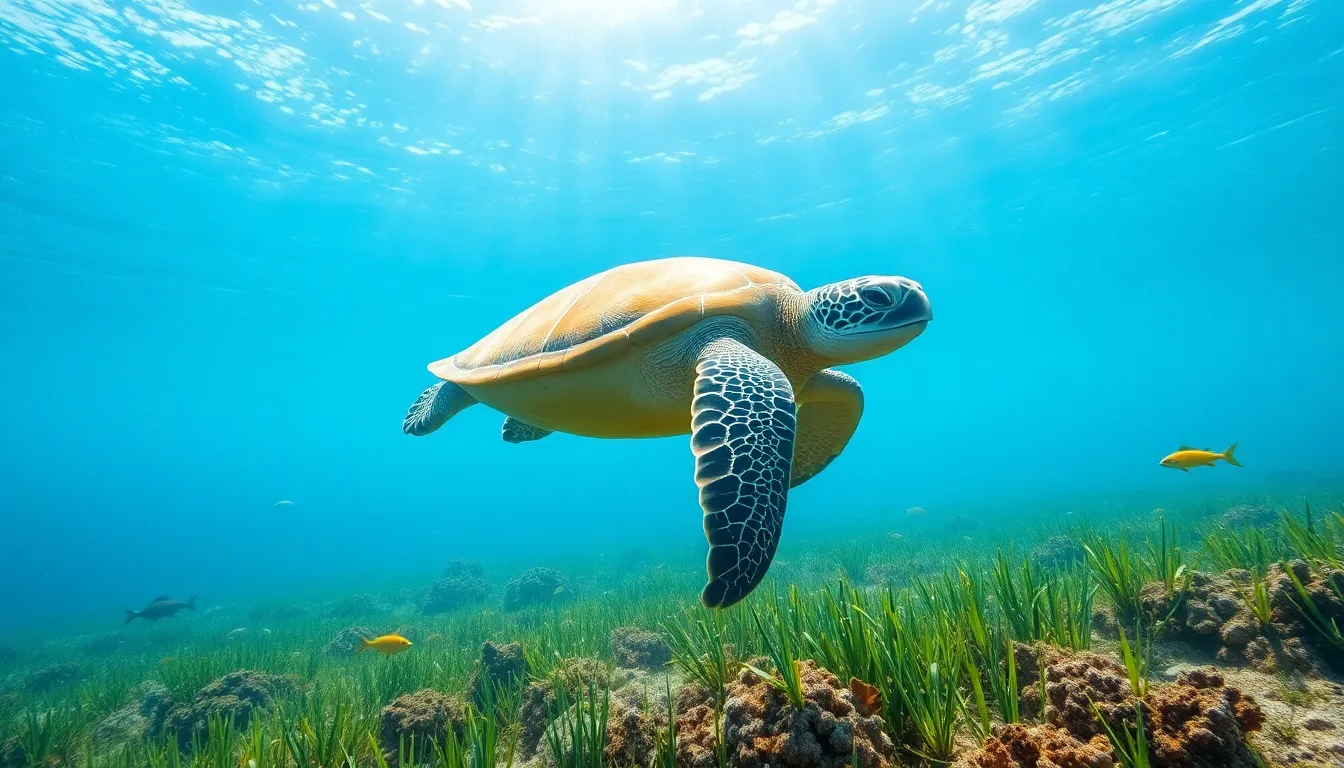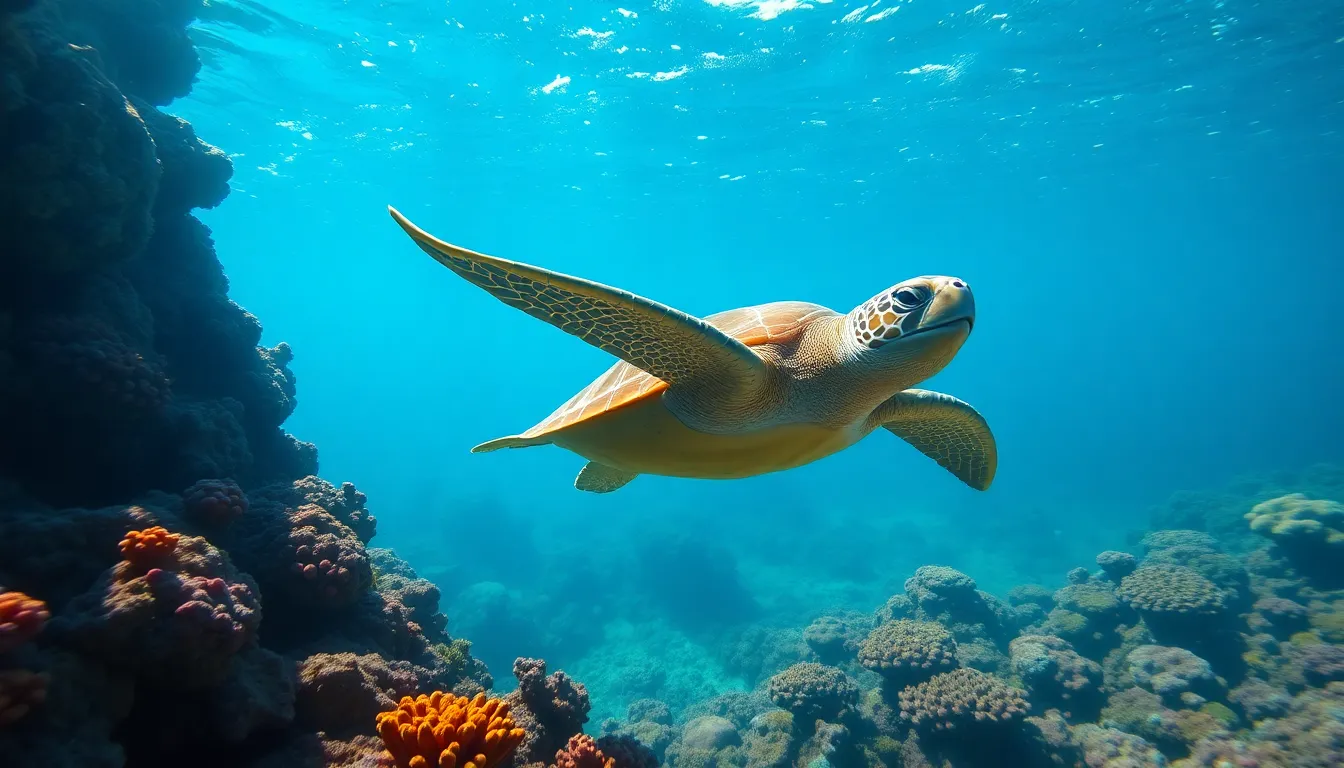Table of Contents
ToggleSea turtles are remarkable creatures that have captured the fascination of people for centuries. With their ancient lineage and graceful movements, these reptiles often evoke curiosity about their lifespan. Understanding how long sea turtles live not only highlights their resilience but also underscores the importance of conservation efforts to protect them.
Typically, sea turtles can live anywhere from 50 to over 100 years, depending on the species and environmental factors. Their longevity is a testament to their adaptability and the unique ecosystems they inhabit. As they navigate the world’s oceans, their age becomes a crucial factor in their survival and the health of marine environments. Exploring the lifespan of sea turtles reveals the intricate balance of nature and the need for ongoing preservation initiatives.
Lifespan of Sea Turtles
Sea turtles exhibit impressive longevity, often living between 50 and 100 years. Various factors influence their lifespan, impacting individual survival rates and overall populations.
General Lifespan Estimates
Lifespan estimates vary among different species of sea turtles. Below are some general estimates:
| Sea Turtle Species | Average Lifespan |
|---|---|
| Green Sea Turtle | 60-80 years |
| Loggerhead Sea Turtle | 50-70 years |
| Leatherback Sea Turtle | 50-70 years |
| Hawksbill Sea Turtle | 30-50 years |
| Olive Ridley Sea Turtle | 50-70 years |
Lifespan figures depend on environmental conditions and threats faced, such as pollution, habitat loss, and fishing practices.
Factors Influencing Lifespan
Several factors affect the lifespan of sea turtles:
- Species: Different species exhibit varying lifespans due to genetic traits and ecological adaptations.
- Habitat: Quality of marine and nesting environments influences survival rates. Healthy ecosystems support longer-lived individuals.
- Predation: Natural predators, including sharks and larger fish, pose risks that can shorten life expectancy.
- Human Activity: Illegal hunting, fishing nets, and coastal development significantly threaten sea turtle populations, impacting their longevity.
- Climate Change: Rising sea temperatures and changing ocean conditions may affect food availability and nesting patterns, potentially reducing lifespans.
Recognizing these influencing factors is crucial for effective conservation efforts aimed at protecting sea turtles and their habitats.
Species Variations

Different species of sea turtles exhibit varying lifespans influenced by their unique biological and environmental traits. Here’s a closer look at a couple of notable species.
Green Sea Turtles
Green Sea Turtles often live between 60 and 80 years, although some individuals may reach over 100 years in optimal conditions. They inhabit coastal and open ocean waters, primarily feeding on seagrass and algae. Their longevity is supported by relatively stable environments and fewer natural predators in their adult stages. Conservation efforts focus on protecting their nesting sites and habitats, crucial for maintaining their populations.
Loggerhead Sea Turtles
Loggerhead Sea Turtles exhibit lifespans ranging from 50 to 70 years. These turtles are known for their large heads, which help them forage for hard-shelled prey like crustaceans. They often face threats from fishing gear and habitat loss. Conservation strategies aim to reduce bycatch and protect nesting beaches, thereby aiding in their longevity and survival within their ecosystems.
Environmental Impact on Lifespan
Environmental factors significantly influence the lifespan of sea turtles. Natural predators and human threats present notable challenges that affect their survival rates and overall longevity.
Natural Predators
Natural predators such as sharks, alligators, and larger fish significantly impact juvenile sea turtles. Hatchlings face high mortality rates, with studies indicating that over 90% of hatchlings do not survive to adulthood due to predation. Adult turtles experience fewer natural threats but remain vulnerable to specific predators that can affect species populations, altering their distribution and reproductive success.
Human Threats
Human activities pose significant threats to sea turtle longevity. Habitat loss from coastal development endangers nesting sites, while pollution can harm marine habitats. Fishing gear often leads to bycatch, resulting in accidental captures and deaths. Climate change affects nesting sites and the availability of food sources, further jeopardizing sea turtle populations. Conservation efforts aim to mitigate these human impacts, focusing on habitat protection, sustainable fishing practices, and pollution reduction to enhance sea turtles’ survival prospects.
Captivity vs. Wild Lifespan
Sea turtles exhibit varying lifespans in captivity compared to the wild. Understanding the differences helps clarify their well-being and conservation strategies.
Benefits of Captivity
- Controlled Environment: Captivity allows for stable living conditions, reducing stressors such as predators and food scarcity.
- Regular Health Monitoring: Caretakers can conduct frequent health assessments, ensuring early detection of diseases and injuries.
- Nutritional Management: Specialized diets can meet species-specific nutritional needs, promoting better growth and longevity.
- Conservation Breeding: Captive breeding programs contribute to population recovery efforts for endangered species, allowing for reintroduction into the wild.
- Educational Opportunities: Zoos and aquariums facilitate public education regarding sea turtle conservation, fostering awareness and support for ongoing preservation efforts.
Drawbacks of Captivity
- Limited Space: Captivity often restricts a turtle’s natural range, which can impact physical and mental health.
- Behavioral Issues: Turtles may develop abnormal behaviors in confined settings due to lack of stimulation and inadequate environmental enrichment.
- Shortened Lifespan Potential: Some studies suggest that, despite better controlled care, captive turtles may not reach their maximum lifespan potential compared to wild counterparts.
- Dependency on Humans: Captive sea turtles may become reliant on human care, reducing their survival skills for potential reintroduction into the wild.
- Limited Genetic Diversity: Captive breeding can lead to inbreeding, resulting in reduced genetic variability, which is detrimental to long-term species survival.
Sea turtles are remarkable creatures with lifespans that can span decades. Understanding their longevity highlights the importance of protecting these species and their habitats. Conservation efforts play a crucial role in ensuring that sea turtles can thrive in their natural environments, facing fewer threats from human activities and climate change.
As awareness grows about the challenges they face, it’s vital to support initiatives that promote their well-being. By doing so, future generations can continue to marvel at these ancient mariners, ensuring their presence in our oceans for years to come.






